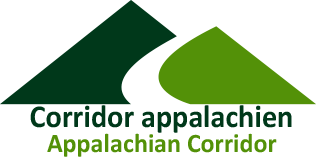
Thanks to Appalachian Corridor and its partners, over 15,000 ha of natural areas on private land are protected in perpetuity in the Appalachian region of Southern Québec.
The Appalachian Corridor’s conservation strategy is based on the design of protected areas and the most up-to-date principles in the field of conservation science with regard to the management of natural areas.

This design includes
Conservation Cores
large enough to ensure the survival of all representative species of the natural region and protect all its ecosystems.
Buffer Zones
around these cores also contribute to the conservation of natural areas while allowing numerous uses that do not compromise the ecological integrity of these areas (e.g. sustainable forestry activities)
Biodiversity Hotspots
wetlands, fragile habitats, or habitats used by species at risk, located inside or outside conservation cores.
Corridors
that link these core areas are also an integral part of the conservation strategy, since they help maintain connectivity, an essential function for the dispersion of plant species and viability of animal populations since they enable species movements and facilitate genetic diversity.

The day-to-day application of scientific principles
Appalachian Corridor’s transborder conservation strategy is based on scientific principles fed by knowledge acquisition projects.
Surveys of natural areas allow us to confirm the presence of species at risk and identify key habitats to protect in priority. Plants, amphibians, reptiles, birds and mammals surveys allow us to collect data used for specific conservation measures development on species listed in areas identified by Appalachian Corridor and its partners.
This scientific analysis through a Geographic Information System (GIS) helps us identify priority areas for conservation within the territory of action and takes into account methodologies and results from national and international strategies aimed at preserving biodiversity.
At the request of conservation organizations and landowners, Appalachian Corridor’s biologists conduct ecological valuations on properties targeted for conservation actions. The resulting data allow biologists to determine the exceptional value of given properties. This information is integrated into conservation plans aimed to determine specific zones to be protected and the uses allowed within each zone. These plans allow landowners to choose the appropriate conservation tools.
Cohabiter avec la nature ! A transboundary brochure!
Appalachian Corridor partnered with WCS (Wildlife Conservation Society) on developing a landowner tool to protect habitats. The guidebook “Cohabiter avec la nature!” was developed in French to provide guidance on wildlife-friendly residential development and land-use planning in the Appalachians of Southern Quebec, thus extending the reach of the original brochure northwards into Canada. Original illustrations by Jason W. Smith.
We introduced the guide to various audiences
Mayors councils
Municipalities administrations
in events, conferences, conventions and workshops
SPECIES AT RISK MONITORING
COUGAR

PEREGRINE FALCON

BICKNELL’S THRUSH
Credit photo:
Serge Beaudette

CHIMNEY SWIFT

WOOD TURTLE

GOLDEN-WINGED WARBLER




It’s no surprise and the scientific community has been saying it loud and clear for some time: the effects of climate change over the next decades will experiment climate change happen at a much faster pace than what the planet has known to date. Just like us, animal and plant species, as well as natural and semi-natural ecosystems, will have to adapt.
By protecting the most fragile and strategic natural areas, the conservation community intitiated an important work a long time ago. Conserving natural areas contributes to absorb and stock carbon, save typical samples of biodiversity and landscapes, protect exceptional or vulnerable habitats and enable species migration to more suitable habitats.
Adaptation to climate change is well underway: it starts with more intensive conservation efforts. Act now for tomorrow’s change!


